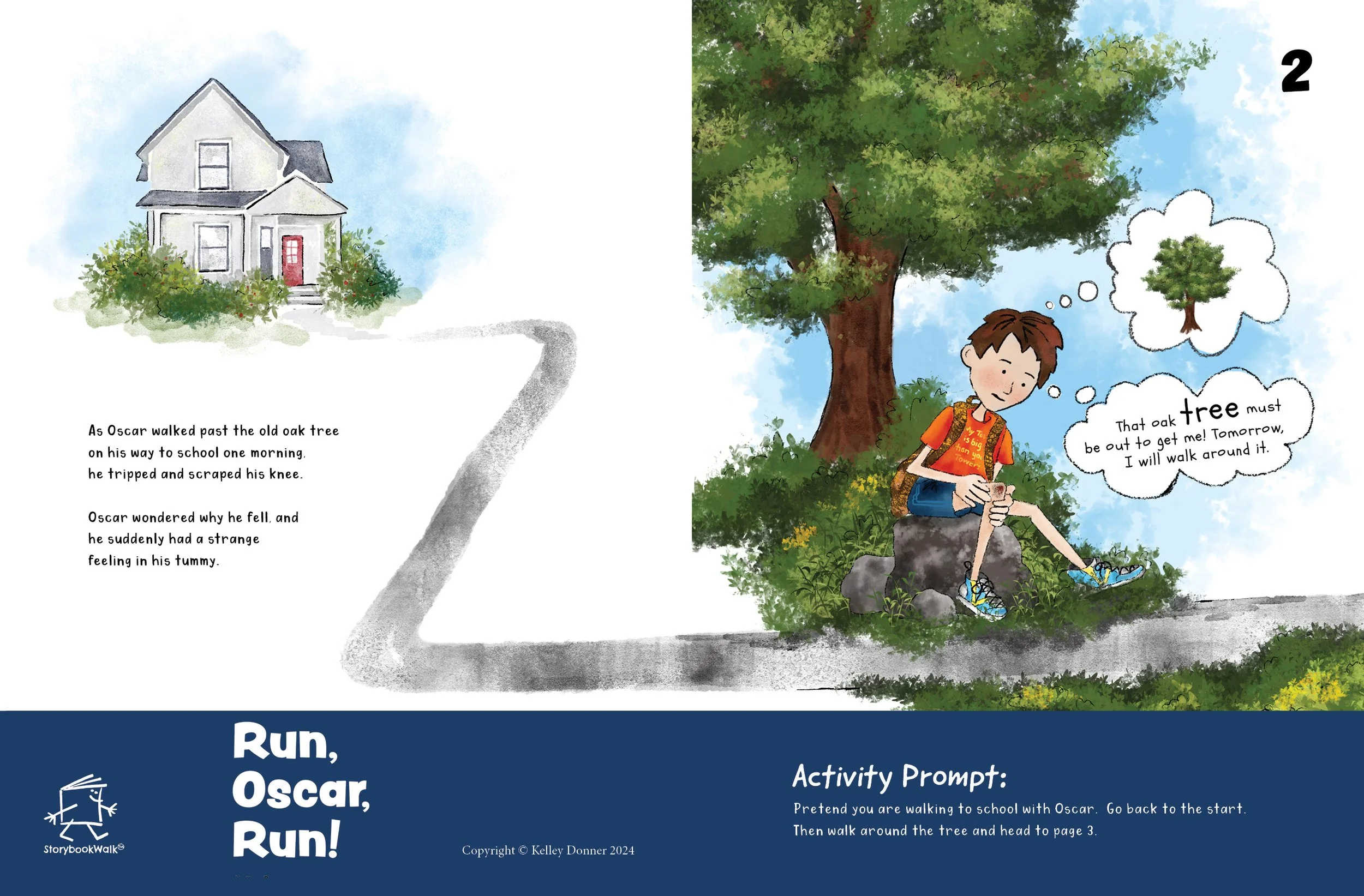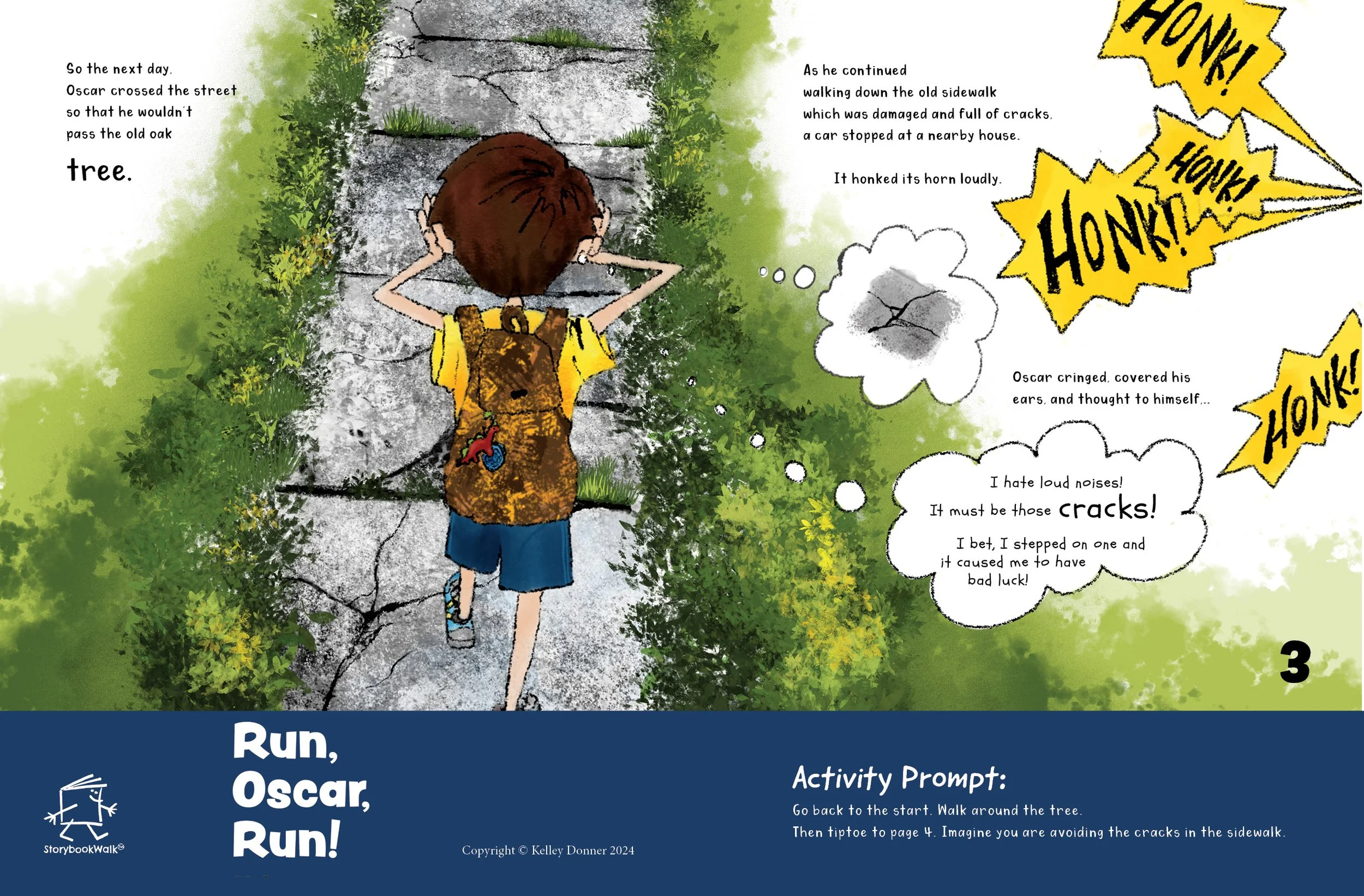 Image 1 of 4
Image 1 of 4

 Image 2 of 4
Image 2 of 4

 Image 3 of 4
Image 3 of 4

 Image 4 of 4
Image 4 of 4





Run, Oscar, Run!: Laminated Storybook Walk Edition
This storybook RUN edition will have children reading and running back and forth between the pages. What a great way to get kids reading AND running! This edition is Ready-to-Use and can be directly implemented in a permanent reading display or hung up as desired.
Contains 14 spreads (fits in 14 frames). An instruction page for this story is also available which extends the walk to 15 frames.
Sizes: 11 × 17 and 18 × 24 inch
Original Title: Run, Oscar, Run!
Buy the paperback book on Amazon!
Author/illustrator: Kelley Donner
Sometimes bad things just happen, but Oscar doesn’t want to believe that. He thinks that there is always a reason and that it is usually his fault. From tiptoeing to avoid cracks in the sidewalk to only wearing certain clothing, Oscar does everything he can to try to avoid things which may have caused him misfortune, especially on his way to school. That is until one day, when he oversleeps, doesn’t have time for his normal routine, and is forced to face his fears head on.
It is often difficult for small children to understand the difference between fantasy and reality, and it is common for them to make false assumptions and correlations. Sometimes children will feel as if their thoughts have a direct impact on their environment or that certain objects have supernatural powers. This could be something as simple as carrying around a good luck charm or a child feeling like if he hadn’t done some behavior his parents would not have gotten a divorce. In psychology, this is called magical thinking and it is common for children between the ages of 2-7. In Run, Oscar, Run! Oscar has a strange feeling after he falls and scrapes his knee one morning on his way to school and decides that somehow the tree was to blame. He can’t get this thought out of his head and decides that it makes the most sense to just avoid the tree. Unfortunately, his magical thinking ends up causing him a lot of distress and he begins to avoid more and more. Most of the time magical thinking is harmless and just part of child development. Nevertheless, in some cases it can become a problem, especially if a child feels as if they are to blame for something bad that happened. Just as Oscar realizes that he had made incorrect correlations and that nothing he did actually caused his distress, it is important for children to know that having thoughts they don’t understand is completely normal.
With its vibrant watercolor illustrations and story of self-discovery, Run, Oscar, Run! is a fantastic book for children to learn about dealing with anxiety and how to overcome their fears one step at a time. It can be used as a teaching tool to help children learn to process their thoughts and to develop more logical thinking skills.
Lesson plans, story-time videos, and more can be found at KelleyDonner.com
Topic: Anxiety, Self-confidence, Physical fitness and well-being
Genre: Children’s Fiction
Ages: 3-8
About the Author/Illustrator
Kelley Donner knew she wanted to be an artist as a little girl where she grew up on a farm in rural Kansas. She has written many children's stories including The Day the Lines Changed, which was featured in the Washington Post as one of the top ten children's books about the pandemic. Kelley has a Masters Degree in Illustration and Book Arts from the Cambridge School of Art and has worked as an educator for over 20 years in the US, UK, and Germany. When Kelley is not busy drawing, you will often find her playing Lego with her three boys.
This storybook RUN edition will have children reading and running back and forth between the pages. What a great way to get kids reading AND running! This edition is Ready-to-Use and can be directly implemented in a permanent reading display or hung up as desired.
Contains 14 spreads (fits in 14 frames). An instruction page for this story is also available which extends the walk to 15 frames.
Sizes: 11 × 17 and 18 × 24 inch
Original Title: Run, Oscar, Run!
Buy the paperback book on Amazon!
Author/illustrator: Kelley Donner
Sometimes bad things just happen, but Oscar doesn’t want to believe that. He thinks that there is always a reason and that it is usually his fault. From tiptoeing to avoid cracks in the sidewalk to only wearing certain clothing, Oscar does everything he can to try to avoid things which may have caused him misfortune, especially on his way to school. That is until one day, when he oversleeps, doesn’t have time for his normal routine, and is forced to face his fears head on.
It is often difficult for small children to understand the difference between fantasy and reality, and it is common for them to make false assumptions and correlations. Sometimes children will feel as if their thoughts have a direct impact on their environment or that certain objects have supernatural powers. This could be something as simple as carrying around a good luck charm or a child feeling like if he hadn’t done some behavior his parents would not have gotten a divorce. In psychology, this is called magical thinking and it is common for children between the ages of 2-7. In Run, Oscar, Run! Oscar has a strange feeling after he falls and scrapes his knee one morning on his way to school and decides that somehow the tree was to blame. He can’t get this thought out of his head and decides that it makes the most sense to just avoid the tree. Unfortunately, his magical thinking ends up causing him a lot of distress and he begins to avoid more and more. Most of the time magical thinking is harmless and just part of child development. Nevertheless, in some cases it can become a problem, especially if a child feels as if they are to blame for something bad that happened. Just as Oscar realizes that he had made incorrect correlations and that nothing he did actually caused his distress, it is important for children to know that having thoughts they don’t understand is completely normal.
With its vibrant watercolor illustrations and story of self-discovery, Run, Oscar, Run! is a fantastic book for children to learn about dealing with anxiety and how to overcome their fears one step at a time. It can be used as a teaching tool to help children learn to process their thoughts and to develop more logical thinking skills.
Lesson plans, story-time videos, and more can be found at KelleyDonner.com
Topic: Anxiety, Self-confidence, Physical fitness and well-being
Genre: Children’s Fiction
Ages: 3-8
About the Author/Illustrator
Kelley Donner knew she wanted to be an artist as a little girl where she grew up on a farm in rural Kansas. She has written many children's stories including The Day the Lines Changed, which was featured in the Washington Post as one of the top ten children's books about the pandemic. Kelley has a Masters Degree in Illustration and Book Arts from the Cambridge School of Art and has worked as an educator for over 20 years in the US, UK, and Germany. When Kelley is not busy drawing, you will often find her playing Lego with her three boys.
